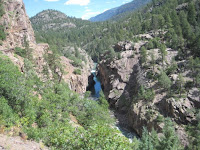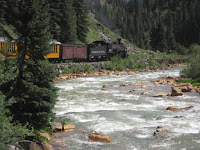








A narrow gauge rail line has the rails three feet apart. A standard gauge rail line has the rails 4 feet eight and one half inches apart. Some say that dimension was picked by the width of two Roman chariot horses. Apparently a horse's ass has been responsible for something! Narrow gauge makes a lot of sense when you have to carve a ledge through steep, rocky mountain terrain. They can make tighter corners and climb steeper inclines and a narrower road bed is signifcantly less work to build.
Today we took the Durango & Silverton Narrow Gauge (D&SNG) from Durango, Colorado to Silverton, Colorado and back. It is about a 40 mile trip and takes three and a half hours each way. Durango is at 6520 feet elevation and Silverton is at 9288 feet elevation. Three different trains made the trip today, last week there were four. Shortly there will be two and then in October there will be none. The tourist season is already waning in this part of Colorado. We learned that they do offer a train around Christmas that goes from Durango to Cascade Canyon, a distance of about 24 miles or a little over half the distance to Silverton. The snowfall is much deeper the closer you get to Silverton and it is too difficult to keep the line open. Cascade Canyon is at 7696 feet elevation. We are already talking about coming back for a ride into the snowy mountains. Pictures will be more difficult to obtain because we sure won't be sitting in open cars or with open windows! Guess someone else will have to take the pictures next time.
Steam locomotives take you back to another era. These are coal burners and the coal smoke was dense and acrid. Small cinders are included in the exhaust smoke and soot collects everywhere the wind takes it. The trip up to Silverton took five times as much coal or energy as the trip back. The fireman was quite busy with his shovel, putting large chunks of coal into the burner which produced vast amounts of steam to power the engine..
Two water stops were scheduled on the trip up, only one for the return trip as not as much water was converted to steam. There are large storage tanks situated on the route where pipe streams provide the water to fill them. A pipe is placed in the stream uphill from the storage tank and this takes water from the stream to fill the tank. An overflow located on the top of the storage tank carries excess water back into the stream where it flows into the Animas River. The train stops at the storage tank and a large fill spout is lowered over the locomotive water tank. A valve is opened and the water pours into the locomotive. It only takes a few minutes to tank up. They raise the fill spout and turn off the valve and within another minute or so the whistle blows and they resume the trip. We were told that the locomotives could go about thirty miles on a tank of water.
We traveled through the outskirts of Durango and followed the Animas River into the mountains. We soon left the suburbs and all housing behind as we got into the San Juan mountains and had a narrow ledge at times with sheer rock walls down to the raging white water below, way below. The line twists and turns as it follows the river and crosses the river at least five times. We had beautiful scenery and a wonderful day for the trip as it was sunny and warm all the way up and back. At times the route is between opposing rock walls, easily within arms reach.
We had a quick lunch in Silverton, at an old bordello, no less. They advertise they no longer offer that service but they do sell food! Silverton has a colorful history as there were several of these establishments back in the 1880s.
We learned that a steam locomotive can not be easily shut off at night. The engines are left idling all night. It is difficult to start and stop the boiler fires so they are left burning. The fuel is changed at night from coal to compressed sawdust pellets and special exhaust scrubbers are placed over the stacks to reduce the emissions of the idling engines. This cuts the emissions by about ten percent.
The D&SNG has been featured in several movies. Remember when Butch Cassidy & The Sundance Kid leapt from a train into the river far below? They did jump from the train but into a net about six feet below! They leaped a second time from about six feet above the river!



1 comment:
Okay....finally figured out how to leave a comment. That certainly confirms that I am a senior hi tech'r :). Love reading your blog and following your travels! Sending love and safe travels to you in your big rig! ~jt
Post a Comment